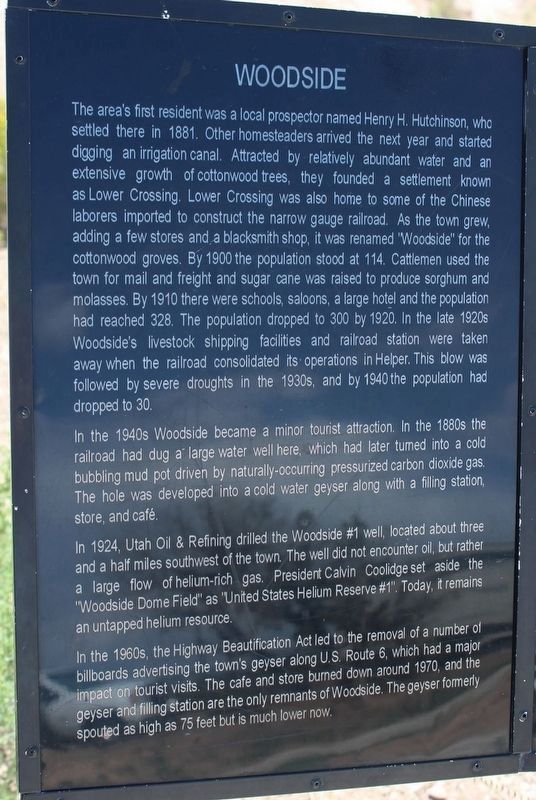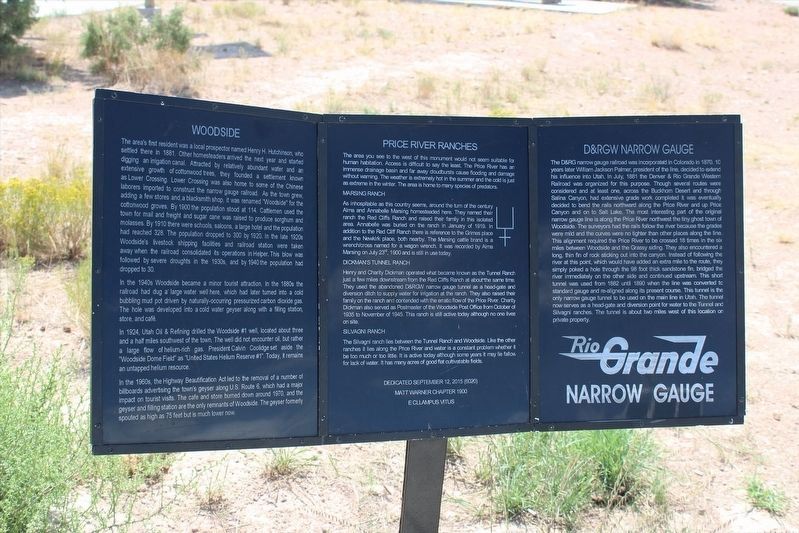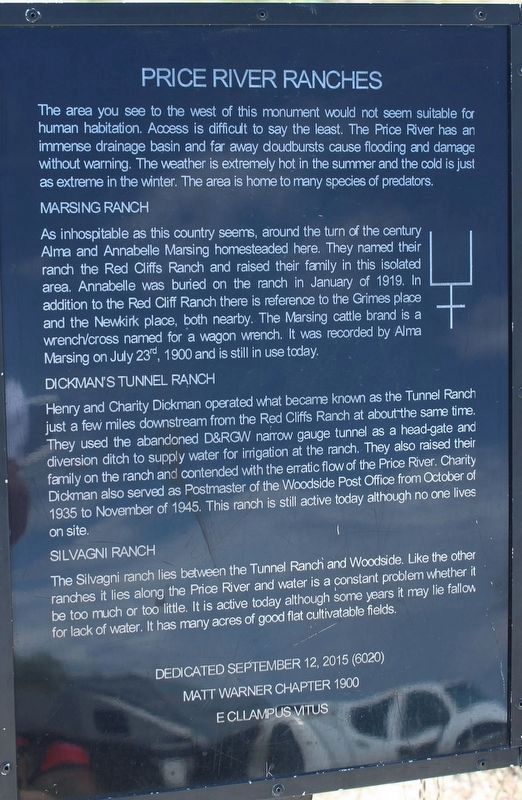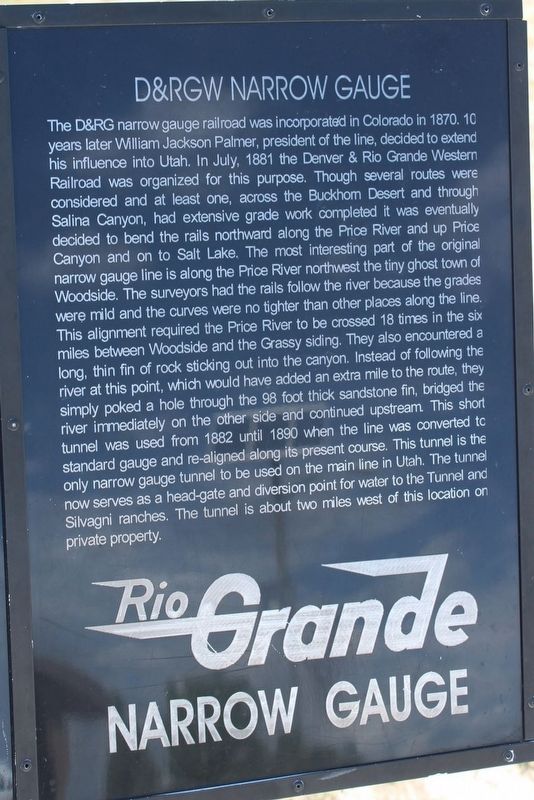Woodside / Price River Ranches / D & RGW Narrow Gauge
Woodside
The area's first resident was a local prospector named Henry H. Hutchinson, who settled there in 1881. Other homesteaders arrived the next year and started digging an irrigation canal. Attracted by relatively abundant water and an extensive growth of cottonwood trees, they founded a settlement known as Lower Crossing. Lower Crossing was also home to some of the Chinese laborers imported to construct the narrow gauge railroad. As the town grew, adding a few stores and a blacksmith shop, it was renamed "Woodside" for the cottonwood groves. By 1900 the population stood at 114. Cattlemen used the town for mail and freight and sugar cane was raised to produce sorghum and molasses. By 1910 there were schools, saloons, a large hotel and the population had reached 328. The population dropped to 300 by 1920. In the late 1920 Woodside's livestock shipping facilities and railroad station were taken away when the railroad consolidated its operations in Helper. This blow was followed by severe droughts in the 1930s, and by 1940 the population had dropped to 30.
In the 1940s Woodside became a minor tourist attraction. In the 1880s the railroad had dug a large water well here, which had later turned into a cold bubbling mud pot driven by naturally-occurring pressurized carbon dioxide gas. The hole was developed into a
cold water geyser along with a filling station, store, and café.In 1924, Utah Oil & Refining drilled the Woodside #1 well, located about three and a half miles southwest of the town. The well did not encounter oil, but rather, a large flow of helium-rich gas. President Calvin Coolidge set aside the "Woodside Dome Field" as "United States Helium Reserve #1". Today, it remains an untapped helium resource.
In the 1960s, the Highway Beautification Act led to the removal of a number of billboards advertising the town's geyser along U.S. Route 6, which had a major impact on tourist visits. The cafe and store burned down around 1970, and the geyser and filling station are the only remnants of Woodside. The geyser formerly spouted as high as 75 feet but is much lower now.
Price River Ranches
The area you see to the west of this monument would not seem suitable for human habitation. Access is difficult to say the least. The Price River has an immense drainage basin and far away cloudbursts cause flooding and damage without warning. The weather is extremely hot in the summer and the cold is just as extreme in the winter. The area is home to many species of predators.
Marsing Ranch
As inhospitable as this country seems, around the turn of the century Alma and Annabelle Marsing homesteaded here. They named their ranch the Red Cliffs Ranch and
raised their family in this isolated area. Annabelle was buried on the ranch in January of 1919. In addition to the Red Cliff Ranch there is reference to the Grimes place and the Newkirk place, both nearby. The Marsing cattle brand is a wrench/cross named for a wagon wrench. It was recorded by Alma Marsing on July 23rd, 1900 and is still in use today.Dickman's Tunnel Ranch
Henry and Charity Dickman operated what became known as the Tunnel Ranch just a few miles downstream from the Red Cliffs Ranch at about the same time. They used the abandoned D&RGW narrow gauge tunnel as a head-gate and diversion ditch to supply water for irrigation at the ranch. They also raised their family on the ranch and contended with the erratic flow of the Price River. Charity Dickman also served as Postmaster of the Woodside Post Office from October of 1935 to November of 1945. This ranch is still active today although no one lives on the site.
Silvagni Ranch
The Silvagni Ranch lies between the Tunnel Ranch and Woodside. Like other ranches it lies along the Price River and water is a constant problem whether it be too much or too little. It is active today although some years it may lie fallow for lack of water. It has many acres of good flat cultivatable fields.
D&RGW Narrow Gauge
The D&RGW narrow gauge railroad was incorporated in Colorado in 1870. 10
years later William Jackson Palmer, president of the line, decided to extend his influence into Utah. In July, 1881 the Denver & Rio Grande Western Railroad was organized for this purpose. Though several routes were considered and at least one, across the Buckhorn Desert and through Salina Canyon, had extensive grade work completed it was eventually decided to bend the rails northward along the Price River and up Price Canyon and on to Salt Lake. The most interesting part of the original narrow gauge line is along the Price River northwest of the tiny ghost town of Woodside. The surveyors had the rails follow the river because the grades were mild and the curves were no tighter than other places along the line. This alignment required the Price River to be crossed 18 times in the six miles between Woodside and the Grassy Siding. They also encountered a long, thin fin of rock sticking out into the canyon. Instead of following the river at this point, which would have added an extra mile to the route, they simply poked a hole through the 98 foot thick sandstone fin, bridged the river immediately on the other side and continued upstream. This short tunnel was used from 1882 until 1890 when the line was converted to standard gauge and re-aligned along its present course. This tunnel is the only narrow gauge tunnel to be used on the main line in Utah. The tunnel now serves as a head-gate and diversion point for water to the Tunnel and Silvagni ranches. The tunnel is about two miles west of this location on private property.
Dedicated September 12, 2015 (6020)
Matt Warner Chapter 1900
E Clampus Vitus
Erected 2015 by Matt Warner Chapter 1900 E Clampus Vitus.
Topics and series. This historical marker is listed in these topic lists: Environment • Man-Made Features • Railroads & Streetcars • Settlements & Settlers. In addition, it is included in the E Clampus Vitus, and the Former U.S. Presidents: #30 Calvin Coolidge series lists. A significant historical month for this entry is January 1919.
Location. 39° 24.718′ N, 110° 25.873′ W. Marker is near Woodside, Utah, in Emery County. Marker is on Horse Canyon Road, on the left when traveling east. The marker is located at the Horse Canyon View Area Rest Stop, just across from the restrooms. Touch for map. Marker is in this post office area: East Carbon UT 84520, United States of America. Touch for directions.
Other nearby markers. At least 2 other markers are within 11 miles of this marker, measured as the crow flies. Rock Asphalt (approx. 10.9 miles away); Settlement of East Carbon (approx. 10.9 miles away).
Credits. This page was last revised on July 31, 2020. It was originally submitted on March 27, 2019, by Frank Gunshow Sanchez of Hollister, California. This page has been viewed 221 times since then and 28 times this year. Photos: 1, 2, 3, 4. submitted on March 27, 2019. • Andrew Ruppenstein was the editor who published this page.



